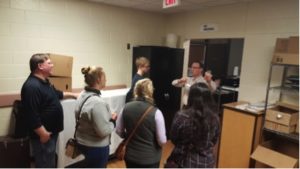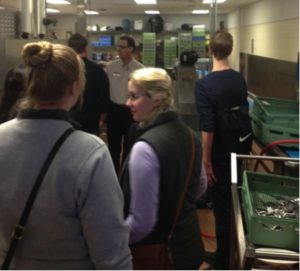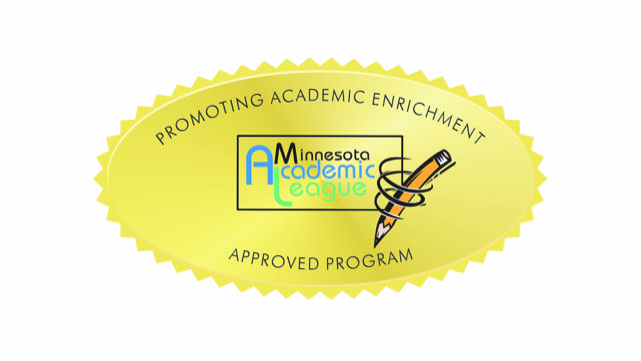By Laurentian staff member Sam Horner
What happens to our garbage when it is thrown away? Is it really gone or is it just out of our minds for the time being? This YES! Winter Workshop took place at the University of Minnesota Duluth for the Duluth East YES! team. Every topic revolved around waste and what happens when garbage is thrown away. There were four different speakers and each gave a different view on sustainability and waste.
 First off was meeting with Mindy Granley, Director of UMD Sustainability. What does it take to create real change? Will a ten page paper do the job or will a PowerPoint create the needed change? Mindy had seen all these things done and nothing seemed to be working. Then she came up with an idea to put their garbage on display for students to see. Her team un-bagged all the garbage that had been collected in one day at UMD and spread it out on tarps in a high traffic area of the school. They then proceeded to sort all the trash from the recyclables and compost. After going through every bag they realized a shocking fact; of all the garbage students were throwing away only 30% needed to be in the trash. The other 70% could have been recycled or composted. This really gave their department a lot of steam moving forward. The main culprit they found were styrofoam cups which are neither recyclable nor compostable. After an enormous amount of research and pressure, they were able to convince the campus coffee shops to switch to compostable cups. To say that UMD is perfect in sustainability would be incorrect, but with a great deal of hard work they are becoming more sustainable as the days roll forward. After learning how UMD Sustainability Office became a driving force at the university, we took a stroll to see how food and other waste was being handled at a popular eatery on campus.
First off was meeting with Mindy Granley, Director of UMD Sustainability. What does it take to create real change? Will a ten page paper do the job or will a PowerPoint create the needed change? Mindy had seen all these things done and nothing seemed to be working. Then she came up with an idea to put their garbage on display for students to see. Her team un-bagged all the garbage that had been collected in one day at UMD and spread it out on tarps in a high traffic area of the school. They then proceeded to sort all the trash from the recyclables and compost. After going through every bag they realized a shocking fact; of all the garbage students were throwing away only 30% needed to be in the trash. The other 70% could have been recycled or composted. This really gave their department a lot of steam moving forward. The main culprit they found were styrofoam cups which are neither recyclable nor compostable. After an enormous amount of research and pressure, they were able to convince the campus coffee shops to switch to compostable cups. To say that UMD is perfect in sustainability would be incorrect, but with a great deal of hard work they are becoming more sustainable as the days roll forward. After learning how UMD Sustainability Office became a driving force at the university, we took a stroll to see how food and other waste was being handled at a popular eatery on campus.
 Of all the wonderful places that students can go to eat in Duluth, many of them happily choose to eat at the Dining Center. The Dining Center (DC) caters to over 10,000 meals for students every day. One of the managers of the DC, Floyd Lentz, was happy to give us a tour. To help reduce waste from the beginning, Floyd and his team want to order the right amount of food. Looking back at historical trends and adjusting the data to current student enrollment, Floyd is able to order within one to two percent of the food actually needed. With the ability to order food so precisely, they are able to keep their food waste low from the start. In another effort to keep food waste low, the DC removed the use of trays. This was a decision that came about because students were putting too much food on their plates and it was all being thrown away. When students use plates instead of trays, the actual food waste is much lower. One other aspect Floyd utilizes is called a pulper. The pulper shreds all the food waste up and they are able to send it to WLSSD for composting. With these three different techniques, Floyd and his team have been able to cut the food waste from thousands of pounds a week to mere hundreds. With less energy being consumed to transport and store all this waste, they are able to save a generous amount of money and our landfills are not filling up as fast.
Of all the wonderful places that students can go to eat in Duluth, many of them happily choose to eat at the Dining Center. The Dining Center (DC) caters to over 10,000 meals for students every day. One of the managers of the DC, Floyd Lentz, was happy to give us a tour. To help reduce waste from the beginning, Floyd and his team want to order the right amount of food. Looking back at historical trends and adjusting the data to current student enrollment, Floyd is able to order within one to two percent of the food actually needed. With the ability to order food so precisely, they are able to keep their food waste low from the start. In another effort to keep food waste low, the DC removed the use of trays. This was a decision that came about because students were putting too much food on their plates and it was all being thrown away. When students use plates instead of trays, the actual food waste is much lower. One other aspect Floyd utilizes is called a pulper. The pulper shreds all the food waste up and they are able to send it to WLSSD for composting. With these three different techniques, Floyd and his team have been able to cut the food waste from thousands of pounds a week to mere hundreds. With less energy being consumed to transport and store all this waste, they are able to save a generous amount of money and our landfills are not filling up as fast.
Next on the agenda was a presentation about Minnesota’s landfills by one of UMD’s professors, Moe Benda. The YES! team learned about how they were constructed. The construction of the landfill helps to prevent any waste water from leaching into lakes or rivers. Unfortunately, landfills also produce methane. At this point in St. Louis County, there is not a practical way to harness the methane and put it to good use. So the methane is left to rise into the atmosphere adding to greenhouse gases. Without these landfills to keep all our garbage, there would be a whole heap of other problems that would need attention. Lunch was next on the agenda and the YES! team and coordinators gave the challenge of zero waste. To the knowledge of the coordinators, the only waste that was generated was napkins!
To end the day, Jenna Totz of Climate Generation gave a thrilling presentation on the life of our consumer goods and how it relates to climate change. Our consumer goods have a long life. It is longer than being on the shelf and being in someone’s home. How did that product come to be manufactured? How many miles did it have to be shipped to get to the store? Jenna Totz showed the YES! team how the life of a product can really affect our earth. Whether it’s from the manufacturing phase, or the many miles it needs to be shipped to arrive at the store, or when it has potentially outlived its usefulness, all these factors relate to climate change. When that product is thrown away, whether it is ready to be thrown away or people just want something new, that product takes up space in the landfill. Jenna reinforced the need for reduce, reuse, recycle with the YES! team.
For the Duluth YES! team, this Winter Workshop was a great experience. It helped to open their eyes about some of the waste problems and solutions that are affecting the earth. Changing the status quo at their school might seem like an insurmountable task, but starting with small projects to show people why this is important is a great place to start. When the rest of the school sees your passion and enthusiasm, it will be hard to stop our momentum. Good luck and may great results come about because of your YES! projects this year Duluth East!
